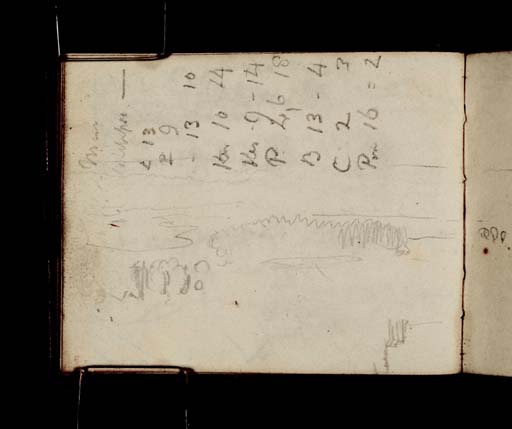Joseph Mallord William Turner Mortham Tower; and an Itinerary 1831
Image 1 of 2
Joseph Mallord William Turner,
Mortham Tower; and an Itinerary
1831
Joseph Mallord William Turner 1775–1851
Folio 7 Verso:
Mortham Tower; and an Itinerary 1831
D25537
Turner Bequest CCLXIV 7a
Turner Bequest CCLXIV 7a
Pencil on white wove paper, 74 x 94 mm
Inscribed in pencil by Turner with the sketchbook turned to the right
Inscribed in pencil by Turner with the sketchbook turned to the right
Accepted by the nation as part of the Turner Bequest 1856
References
1909
A.J. Finberg, A Complete Inventory of the Drawings of the Turner Bequest, London 1909, vol.II, p.847, CCLXIV 7a, as ‘Landscape.’.
This double-page sketch, continuing on folio 8 (D25538), may show a view north from Greta Bridge towards Mortham Tower and the River Greta. A building on folio 8 matches the tower, house and outbuildings of Mortham Tower, the wooded area in the centre of the present page could be Mortham Woods, with a serpentine line to its left forming the same shape as the River Greta at this point.
The list on this page, written with the sketchbook turned to the right, probably refers to the itinerary of Turner’s tour. Although there are no certain place names, several of the abbreviations correspond closely to places visited by Turner on his route, although the order does not directly correspond.
Mus
L[...] –
L 13
P 9
– 13 10
Kn 10 – 14
Kes 9 14
P 4,6 18
B 13 – 4
C 2 3
Pen 16 = 2
L[...] –
L 13
P 9
– 13 10
Kn 10 – 14
Kes 9 14
P 4,6 18
B 13 – 4
C 2 3
Pen 16 = 2
At the top of the list may be written ‘Man’, for ‘Manchester’ which Turner passed through on his route north. Beneath this the word is very faint, but what looks like ‘pp’ could suggest ‘Appleby’, or perhaps it is the ‘bb’ in ‘Abbotsford’. ‘L’ could be many places on the tour: Liverpool, Lochmaben, Lockerbie, Langholm. ‘P’ could be ‘Penrith’, though this is more likely to be represented at the end of the list. ‘Ken’ and ‘Kes’ stand for ‘Kendal’ and ‘Keswick’ in the Lake District. ‘P’ follows once more, followed by ‘B’, which is more likely to stand for ‘Berwick’. ‘C’ may represent ‘Carlisle’, and finally ‘Pen’ is likely to be an abbreviation of ‘Penrith’.
Turner’s route could not have followed the order of this interpretation of the itinerary, so either the order is arbitrary, or there are mistakes in this reading. The significance of the numbers remains obscure. The two columns suggest that they cannot be distance between places, and the numbers are too low to correspond with any of the places. The two columns are more suggestive of prices. However, if they are read as pounds and shillings, then the figures are too high to correspond to travel or lodging costs. A more likely explanation may be two separate columns of prices in shillings, which could plausibly correspond to lodging and coach fairs. However, the discrepancy between the higher and lower numbers suggests this is also unlikely.
Thomas Ardill
September 2009
How to cite
Thomas Ardill, ‘Mortham Tower; and an Itinerary 1831 by Joseph Mallord William Turner’, catalogue entry, September 2009, in David Blayney Brown (ed.), J.M.W. Turner: Sketchbooks, Drawings and Watercolours, Tate Research Publication, December 2012, https://www


